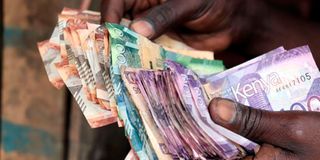Economy grows 10pc in second quarter on lifting of Covid rules

The economy expanded by Sh515 billion more after it was rebased in September to capture new sectors whose output had grown in recent years.
What you need to know:
- It marks a major recovery from the 4.7 per cent contraction seen in the same quarter last year.
- President Uhuru Kenyatta on October 20 lifted the night curfew after a sharp decline in infections.
Kenya’s economy grew 10.1 percent year-on-year in the second quarter of 2021, the highest in more than four decades, buoyed by rebounding activity in most economic sectors after the state relaxed restrictions put in place to curb the spread of Covid-19.
It marks a major recovery from the 4.7 percent contraction seen in the same quarter last year when the economy came under pressure from the outbreak of the pandemic.
The performance is also an improvement from the paltry 0.7 percent growth recorded in the first quarter of this year.
“The performance was supported by rebounds in most economic activities from significant contractions in the second quarter of 2020. The growth recorded was mainly as a result of easing of Covid-19 containment measures that facilitated gradual resumption of economic activities,” Treasury Cabinet Secretary Ukuru Yatani said.
Kenya’s economic activity was subdued for more than a year — hurt by measures imposed in March 2020 to curb the spread of coronavirus including a country-wide dusk-to-dawn curfew, restrictions on travel in and out of the capital Nairobi and closure of learning institutions, hotels and restaurants.
President Uhuru Kenyatta on October 20 lifted the night curfew after a sharp decline in infections and hospital admissions reported in the preceding weeks.
Accelerated growth
It was the latest and one of the most significant easing of restrictions following earlier ones such as allowing foreign travel and resumption of learning in schools, universities and colleges. Data by the Kenya National Bureau of Statistics (KNBS) shows that the quarter two Gross Domestic Product (GDP) growth was supported by strong performance in key economic sectors including manufacturing, education and transport.
The manufacturing sector’s real GDP grew by 9.6 per cent in the second quarter of 2021 compared to a contraction of 4.7 per cent in the same period of 2020.
“Manufacture of dairy, bakery, and tobacco products registered a substantial growth. Production of non-food products rose by 12.2 per cent in the second quarter of 2021,” KNBS said.
The improved activity in manufacturing was particularly felt in motor vehicle assembly that grew by 10 percent, while manufacturers of galvanized iron sheets and paper and paper products recorded growths of 34.5 percent and 13.5 percent, respectively.
The transport and storage sector lent strong support in the second quarter, posting a growth of 16.9 percent—marking a rebound from a 16.8 percent contraction in a corresponding quarter of 2020.
“The accelerated growth was as a result of lifting of the restrictions on domestic and international movement which was in place in the second quarter of 2020,” the statistics office said.
The accommodation and food services sector also registered a gradual rebound to post a 9.1 percent growth in the second quarter compared to a 56.8 percent contraction in a similar period of 2020.
National economic data
“This sector was the most affected by the Covid-19 pandemic in 2020, registering significant decline in number of visitor arrivals by over 99 percent, scaling down of hotel operations and in some cases closure of some facilities in the second quarter,” KNBS said.
The dominant agriculture sector recorded a slowed performance in the second quarter, contracting by 0.9 percent compared to a growth of 4.9 percent in the corresponding quarter of 2020.
The sector’s performance was cushioned from a steeper slump by a notable increase in milk production, horticultural exports and production of sugarcane. The economy expanded by Sh515 billion more after it was rebased in September to capture new sectors whose output had grown in recent years.
The review of national economic data — commonly known as rebasing — increased 2019 GDP in nominal terms to Sh10.2 trillion up from Sh9.7 trillion. This was much lower than the 25.4 percent jump when Kenya rebased the economy a decade ago that increased 2013 GDP from Sh3.6 trillion to Sh4.3 trillion.
The rebasing in 2014 allowed the government to account for changes in the production structure, relative to product prices and products, which led to changes in the size of GDP, growth rates, contributions by sector, and related indicators.
Central Bank of Kenya Governor Patrick Njoroge said in September that the country’s economic growth is expected to rebound this year, helped by sectors such as manufacturing, but that growth could be curtailed by the impact of drought on the agricultural sector. Growth this year would be 6.1 percent and 5.6 percent in 2022, he told a virtual news conference.





